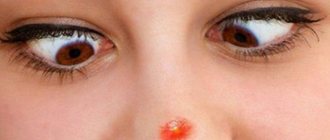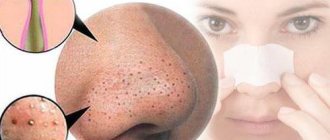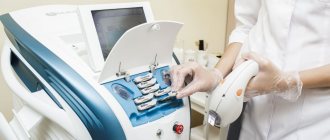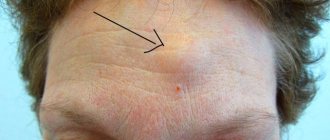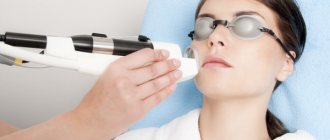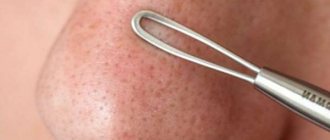Spider veins on the body
Externally, spider veins resemble spiders, as can be seen from their photos. One such asterisk consists of a central arteriole and small vessels, clearly visible on the skin. The vessels extend from the arteriole in different directions. It may also resemble a sun drawn by a small child.
The size in diameter will range from very small, no larger than a pinhead, to 0.5 cm. Looking at enlarged photos on the Internet, you might think that they are much larger. If the size is large, upon palpation the doctor may notice its pulsation, which noticeably increases with pressure. And if you press on the very center of the arteriole, it will turn pale in appearance.
Most often they appear in the following diseases and conditions of the body:
- Viral hepatitis.
- Cirrhosis, including alcoholic.
- Pregnancy in women.
They can appear even in healthy people, but disappear very quickly. In a healthy person, such manifestations may go unnoticed, but with cirrhosis and other liver lesions they become quite numerous.
It is impossible to judge by the few vessels of this type that appear; a significant increase in their number is a reason to urgently go to the doctor and examine your liver.
Cause of spider veins
Spider veins are a manifestation of vasodilation. And they expand with cirrhosis when the liver ceases to cope with its functions, and blood filtration becomes difficult. Stagnation occurs, due to which the vessels dilate, losing their elasticity.
If the treatment of the disease is successful, the elasticity of the vessels begins to return, and the venous “spiders” disappear from the skin. And they return when the disease progresses. Along with them appear:
- Other dilated vessels, appearing as red stripes and dots on the skin, are located in a chaotic manner.
- The appearance of white spots on the arms and buttocks, noticeable when the skin cools. In these places, new dilated arterioles with vascular rays are formed.
- Other external symptoms observed in cirrhosis.
By the appearance of dilated vessels in combination with other characteristic symptoms, the disease can be diagnosed. If a lot of venous stars appear on the skin, and the skin itself begins to turn yellow and dry out, it’s time to promptly consult a doctor and check your liver. If you don't know exactly what they look like, look at the photo and compare.
In other cases, they appear in women due to hormonal disorders, and in men due to venous insufficiency. So they may turn out to be a congenital pathology, manifesting itself completely painlessly, but significantly spoiling the appearance. This disease is considered chronic.
Where venous stars appear
In cirrhosis, venous stars can be found in the area of the superior vena cava, which runs to the heart from the head. Below the nipple area they are rarely observed. Usually located in the décolleté area, along the forearms and on the face. They can be found on the back of the hands, and in rare cases, on the mucous membrane of the nose or mouth.
Accompanied by other dilated vessels, this is especially noticeable on the face and décolleté. This symptom is called "money bill syndrome" because the appearance is similar to the random arrangement of hairs on dollar bills.
Causes and treatment of rosacea on the nose
Couperosis (telangiectasia) is the expansion of small subcutaneous vessels on the face, resulting in the formation of a noticeable red mesh on the skin of the chin or wings of the nose. Although the condition is rarely harmful and painful, it greatly spoils a person’s appearance, forcing him to consult a doctor.
Cooperosis on the nose is a consequence of the inability of individual vessels to contract normally. The vessels expand too much, and at the same time they cannot narrow back.
Acquired rosacea
11 best creams and ointments for rosacea on the face
People with dry and thin skin are predisposed to telangiectasia, but there are other factors:
- The likelihood of rosacea occurring is higher if the disease was observed in parents.
- If a person spends too much time under the scorching sun or visits solariums, then excessive exposure to ultraviolet radiation can damage the vascular walls.
- Being in an environment that is too hot or cold. Even a single hypothermia can cause vasodilation. People forced to stay in the cold for a long time often suffer from rosacea. The disease also occurs in those who work at high temperatures. Representatives of professions such as metallurgist or bakery worker are at risk.
- Bad habits. A distinctive feature of the appearance of any “heavy drinker” is the red web of blood vessels on the skin of the face. But even moderate alcohol consumption increases the likelihood of developing rosacea. Cigarettes and facial microvessels are harmful.
- Rough impact on the skin during cosmetic procedures: serious damage is caused to blood vessels.
- Liver diseases (hepatitis, cirrhosis, etc.).
- Nutrition is an important factor. To prevent rosacea, you need to exclude unhealthy foods from your diet (fatty foods, confectionery, sugary drinks).
- Rosacea.
- Prolonged depression and negative emotional experiences are common causes of rosacea. Due to severe stress, the pressure in the blood vessels increases, having a detrimental effect on the skin.
- Hormonal disorders, pathology of the cardiovascular system and gastrointestinal tract. In such a situation, rosacea acts as a unique way for the body to announce serious problems.
Other external signs of the disease
With cirrhosis, in addition to spider veins, other external signs are noted. It is impossible to make such a diagnosis based on one characteristic symptom: it may be temporary or relate to the clinical picture of some other disease. A large number of dilated vessels that are visible on the skin is a reason to consult a doctor. And you definitely can’t do without it if the following external symptoms were also noted:
- Bright red palms compared to the rest of the skin.
- Yellowish tint of the skin except for the palms.
- White nails, completely opaque.
- Darkened color of urine.
- A bitter taste in the mouth, which may come with hepatic halitosis.
- Bleeding gums.
- Swelling of the veins in the umbilical region and unhealthy rounding of the abdomen due to fluid accumulated in the abdomen.
Spider veins themselves do not appear in all patients with cirrhosis, so you need to pay special attention to the symptoms as a whole. Impaired liver function can lead to irreparable consequences; if external symptoms are detected and a state of general malaise is observed, you must consult a doctor, take tests and undergo a hardware examination. It will be easier to try to reverse the disease than to only try to prevent complications and count the remaining years of life.
Stages of development of rosacea
- The first stage is characterized by the fact that after drinking alcohol and thermal procedures, severe redness of the face is observed, which is caused by persistent dilation of blood vessels. Gradually, the redness disappears, but it may appear again and be the beginning of the development of rosacea.
- The second stage - a vascular pattern begins to appear on the skin, and the vessels lose their ability to contract to their normal state. There is a feeling of dry skin. If you do not contact a cosmetologist at this stage, rosacea may progress.
- The third stage – skin nutrition and microcirculation are disrupted, stagnation and inflammation are observed, and rosacea may develop. In this case, complex treatment is required.
Classifications of the disease
Spots of rosacea do not appear immediately; often, first one thin thread of purple, burgundy or blue appears on the body. Then new threads of various sizes begin to protrude around it. Gradually a large spot appears, which is called a spider vein. They can appear on the arms, skin, thighs, face and other parts of the body. At this moment, changes occur inside the body, and the vascular walls weaken. Depending on their type (veins, capillaries, arteries), different shapes and colors of formations can be observed. Spider veins on the nose and on the face in general are most often capillary, and therefore have a red color.
What do spider veins look like and their classification:
- Spot. They look like dark dots surrounded by a network of purple capillaries.
- Vascular cobwebs. They look like spider legs, which is why they got their name. They form around one place, over time they can increase in size and new ones appear.
- Spiral. Most often they are red in color and look like writhing vessels that are not connected to each other.
- Tree-like. They form around large veins, creating a tree-like pattern.
The location and size of the stars help doctors determine the cause of the problem. For example, an uzist only needs to find a few venous stars to pay attention to the gall bladder, so the initial stage of enlarged veins and the appearance of stars on the skin is sometimes a very useful find.
The mechanism of rosacea formation
It is worth knowing that rosacea is bursting red blood vessels on the face. Their thin walls cannot withstand the pressure inside, and the vessel ruptures. This is how an unsightly cosmetic defect is formed. Capillaries on the nose have various causes (given above), but additional provoking factors for their formation are:
- Too frequent use of salon cosmetic procedures. In this case, thin vessels cannot withstand mechanical stress on the skin. And, as you know, where it is thin, it breaks.
- Increased physical activity and overexertion. In particular, we are talking about strength training or hard physical backbreaking work.
- Frostbite on the face and sudden changes in temperature around.
Important: the risk group in this case includes people with hypertension (high blood pressure).
Source of the disease
Now we know what a spider vein is. But why do spider veins suddenly appear? As we have already learned, spider veins on the body are a manifestation associated with the dilation of blood vessels against the background of hormonal or other diseases. To be more precise, the following list reflects a number of ailments that are the source of the appearance of spider veins.
Spider veins can appear due to liver diseases and injuries.
- Blood clotting disorders, hypovitaminosis, venous hypotonicity, decreased vascular tone.
- Pregnancy, as well as a sudden hormonal surge caused by natural causes or taking special medications.
- Liver diseases and injuries.
- Abuse of UV rays.
- Prolonged stress on the legs, arms and back, excess weight.
- Spinal diseases.
Considering the above, spider veins appear with cirrhosis of the liver, and manifestations are typical on the upper torso and on the palms. This liver disease is called liver palms. But rosacea can also appear for more trivial reasons, such as adolescence in a child, excess weight, frequent exposure to the sun, etc.
Recommendations from cosmetologists and nutritionists
Thin and rosacea-prone facial skin should be protected. Moreover, first of all, you should give up unhealthy foods, such as coffee and chocolate, smoked meats, marinades, spicy dishes and too hot food. Cosmetologists advise the following:
- Avoid mechanical and chemical effects on the skin. If you are prone to rosacea, harsh facial cleansing, chemical peeling and rough scrubbing are contraindicated.
- Avoid tanning beds and direct sunlight.
- The use of ice cubes and hard vacuum massage are prohibited.
- It is advisable to purchase skin care creams that contain grape seed oil.
- It is worth taking a morning contrast shower, which will significantly increase vascular tone.
- It is forbidden to wipe your face with a hard towel.
- Visiting the sauna and bathhouse is contraindicated.
In addition to the above, taking vitamin complexes twice a year and constantly consuming fresh vegetables and fruits, which are a source of antioxidants, are recommended.
By identifying the cause of the appearance of a vascular pattern on the nose and face and eliminating it, it is possible to fully overcome rosacea. Therefore, do not delay visiting your family doctor to determine the main cause of the problem.
How to eliminate it for sure
Of all the treatment methods existing today, the most effective are those that limit blood circulation in the damaged area. The essence of this treatment is to glue the enlarged blood area. The blood in it will stop circulating, it will begin to die and over time will be removed by the body, like, for example, a hematoma. Previously, such a procedure included surgery, including severe trauma to the skin and a subsequent long period of rehabilitation.
Modern treatment methods eliminate these problems. Depending on the method chosen, slight redness or pinpoint marks may remain on the skin from the insertion of the tubes, which heal very quickly. The postoperative period has also noticeably shortened, ranging from 2-3 hours to 1 day. You can treat spider veins without interrupting work or other activities.
Have you ever wondered why no one has ever seen varicose veins in stars? The explanation is very simple - modern invasive and rapid treatment methods, the use of the Darsonval apparatus.
Most methods for removing spider veins are low-traumatic and have a minimal recovery period.
Signs of rosacea: how to recognize them
Before you begin treatment for rosacea, you need to make sure that it is this that is bothering you. This disease is characterized by symptoms such as:
- formation on the face of large areas with expanded nodules;
- characteristic location of redness (first of all - the wings of the nose and cheeks, then the forehead and chin);
- bright burgundy color of dilated vessels.
Initially, the stars occupy a small area on the face. However, if left untreated, the affected area will gradually increase. Moreover, such skin ages much faster because it no longer receives nutrients.
In most cases, rosacea does not cause pain or discomfort to a person. But sometimes this disease is accompanied by itching, tingling and burning sensations.
Most often, spider veins form in people with very thin, light-colored skin after the age of thirty.
Attention! If an unhealthy blush appears on your face, and your skin has become drier and more sensitive, pay special attention to it to eliminate the possibility of illness.
Invasive therapy
Microsclerotherapy procedure for spider veins. This method consists of the procedure of soldering blood vessels without visible damage to the skin. A drug is injected into the affected vein (through a needle), damaging the walls of the vessel. This is how it is glued or soldered. The postoperative period consists of wearing a tight bandage for 3-5 days and avoiding hypothermia. Depending on the degree of damage and the number of stars, several procedures may be required to completely get rid of the cosmetic problem. Your doctor will determine the exact amount. The process of sclerotherapy for spider veins has a number of contraindications, which include pregnancy, obesity, menopause, etc.
Laser procedure
One of the most effective ways to glue a vein is to heat it to a temperature when destructive processes in the tissue begin. A laser is suitable for these purposes. To avoid overheating and damage to nearby tissues, cryogenerator cooling is used.
Thermocoagulation
Another way to get rid of stars in a short time. The idea is very similar to the previous one. Under the influence of high temperatures, thermocoagulation occurs, or the destruction of proteins and cells, which leads to soldering of the blood flow. For these purposes, a high-frequency directional emitter is used. After the thermocoagulation procedure, the patient can almost immediately continue to lead his usual lifestyle, following all the doctor’s instructions.
Cryotherapy is a shock procedure designed to strengthen the walls of blood vessels due to sudden changes in temperature. An affordable method of prevention, which is offered by both private clinics and some city hospitals.
Cold therapy is an at-home alternative to cryotherapy. For cold therapy you will need ice or several bandages, some should be in cold water, others in warm water. Bandages are applied alternately.
Remember! The type and number of procedures will be determined by your doctor. A consultation with a doctor will help determine the cause of the disease, begin basic treatment, and then, taking into account all the indications and contraindications, select the right procedure.
The procedure is carried out using high temperatures.
Electrotherapy
Darsonval is a physiotherapeutic device that affects the skin and mucous membranes with pulsed current. Darsonval and the preventive procedure based on it have been known in our country since the times of the USSR, when this device was widely used in treatment rooms. Today you can buy a Darsonval device for personal use and prevent venous swelling. Darsonvalization has received numerous positive reviews online, so it’s worth taking a closer look at this treatment method. You can find darsonval in private or free clinics and sign up for preventive procedures.
Compresses
Know! For skin damaged by rosacea, only cold compresses can be used.
Parsley
Mix the juice obtained from parsley with milk in equal quantities. Soak a gauze or napkin with the mixture and apply the compress to the damaged area for half an hour. This method must be used once every two days.
Black tea
Lotions based on strong tea should be done daily up to three times a day.
Leaf lettuce
The leaves of the plant are thoroughly crushed. The resulting gruel (five tablespoons) is steamed with a liter of boiling water and simmered over low heat for about two hours. After cooling, the resulting broth must be strained.
Apple vinegar
This compress is prepared by mixing equal parts vinegar and water (mineral).
Soda
This compress has a whitening effect and stays on the face for only five minutes. You can prepare a compress by mixing half a liter of water with two small spoons of baking soda.
Know! To eliminate swelling and get rid of irritation, you can mix two teaspoons of soda and three hundred grams of strong tea leaves.
Potato mask
The potato mask has proven itself to be excellent in the fight against unsightly redness. Its preparation boils down to grinding peeled raw potatoes to a pasty state. It is recommended to keep such a mask on your face for twenty minutes to half an hour. You can wash it off with chamomile infusion or plain water.
Ice treatments
For skin affected by rosacea, the use of any ice procedures is considered harmful.
Folk recipe for treatment with green tomatoes
Unripe tomatoes effectively fight rosacea due to the acid they contain. You can use the vegetable in two ways:
- Apply a cut tomato to the damaged areas;
- Lotions are made from tomato juice.
Such treatment must be carried out for ten days, and the duration of the procedure should be limited to five minutes.
Hydrogen peroxide
Peroxide has whitening and disinfecting properties, which are invaluable in the fight against skin defects.
Attention! Recipes for treatment with peroxide differ depending on skin type.
Those with oily skin will benefit from a compress of a three percent peroxide solution applied for twenty minutes.
For dry skin types, peroxide is mixed with olive oil or cream.
Essential oils
Rosemary oil applied to reddened areas for an hour effectively fights rosacea. At the end of the time, the remaining oil must be removed with a damp cloth, but not rinsed off.
Combinations of oils such as:
- rosemary oil + grape seed oil in a ratio of two to five;
- peach + lemon + cypress oil in a ratio of 15:2:2.
Such compositions must be applied to the skin three times a day.
Homemade cream
To get rid of ugly stars, you can prepare a remedy based on your usual cream. For this purpose, both day and night creams are suitable, to which you need to add a crushed ascorutin tablet.
Important! It is more effective to mix the components immediately before application.
Gymnastics
The following simple exercises will help increase the elasticity of the walls of blood vessels:
- we compress our lips and stretch them out in the form of a tube;
- we take air into our mouth and roll it from one cheek to the other;
- raise your chin, while straining the muscles of your face and neck.
Conservative therapy
These methods cannot guarantee a serious result or a complete cure; they are an alternative for those who do not want to subject the body to procedures for vascular adhesions. This is also suitable if spider veins appeared during pregnancy or if we are talking about spider veins in children. This includes the following treatment methods:
- Ointments (for example, Thrombocide gel). Local treatment can achieve visible results by reducing the size of the veins.
- Medications. Vascular strengthening medications and tablets that improve blood circulation complement and consolidate the effect of ointments.
Traditional methods
Is it possible to treat spider veins at home? It is difficult to answer this question unambiguously. Here you need to understand that asterisks signal the presence of pathologies not only with veins or capillaries, but also with more serious diseases. By fighting its cosmetic manifestations, you are not ridding your body of the cause of swollen veins. We recommend that you consult your doctor before starting treatment with folk remedies.
Iodine mesh. The method is suitable for treating stars on the legs; if you are obese, then the iodine method will not help you, because the formation of swollen veins is caused by stretching of the skin. The mesh itself should be small.
At home, spider veins can be cured using green tomatoes.
Green tomatoes. Vegetables are cut into rings, placed on problem areas and, depending on the thickness of the skin, remain on the body for 1 to 5-6 hours.
Garlic. Two cloves of garlic are cut into thin slices and placed in a glass of water for 10-12 hours. Drink 30 minutes before meals in the morning and evening. The course of such treatment is 2 weeks.
Cosmetological methods of removal
Cosmetic removal of telangiectasias is the first stage of therapy. Depending on the severity of spider veins on the face and the focus of their localization, one of the treatment methods is used: laser exposure, photocoagulation, deep cleansing, skin nutrition, photorejuvenation, mesotherapy, ozone therapy, etc.
Cosmetological methods for removing rosacea
Plasticizing masks with a cooling effect
Modeling or plasticizing masks with a cooling effect are a new product in the field of cosmetology. Their composition is represented by sodium alginate, calcium sulfate, diatomite, sodium phosphate. After using the mask, the facial skin is tightened, moisturized, and smoothed.
The essence of the procedure is as follows: the powder is diluted with a special gel until a homogeneous mass is obtained, which is applied to the skin. The mask fills skin defects, nasolabial folds, fine wrinkles. After a few minutes, the mask hardens, forming an impression on the face. The alginate mask tightens the skin, models the oval, normalizes blood circulation, and helps reduce thrombosis.
Deep cleaning
If you have rosacea, you should avoid aggressive deep mechanical peeling (cleansing). In order to narrow the capillaries on the face and normalize blood circulation, it is recommended to use soft peeling. Such cosmetic care will help exfoliate dead cells, regenerate damaged blood vessels, nourish, and rejuvenate.
The most effective peels are milk, almond, coral, salicylic, and glycolic.
Ozone therapy
Using this method, ozone is injected into the affected blood vessels. Under the influence of a chemical, the capillary is oxidized and destroyed. Ozone therapy is characterized by painlessness, absence of scars, cicatrices, and pigmentation. The disadvantage of ozone therapy is that to achieve a cosmetic effect for rosacea, the patient must undergo 5 or more procedures.
Mesotherapy
The method involves subcutaneous injections of vitamins, organic acids, and enzymes. Depending on the specific skin problem, the cosmetologist selects the composition of the cocktail. The patient is given the required dosage of a vitamin cocktail to the depth of the affected capillary. After administration of the substance, a slight tingling sensation is felt in the epidermis. To eliminate rosacea, you need to undergo 7-10 subcutaneous injections at weekly intervals. Contraindications to the procedure are: pathologies of the kidneys and urinary system.
Mesotherapy in the fight against spider veins
Laser (laser coagulation)
Laser coagulation is the most common method for removing dilated capillaries on the face. The essence of the procedure is that a laser beam passes through the epidermis, hits the capillaries, heats them and seals them. After 2-3 weeks, the sealed capillaries dissolve, and no traces of hardware action remain on the upper layer of the epidermis. At the same time, the surrounding healthy tissue is not damaged. For minor foci of rosacea, the patient only needs to undergo 1-2 procedures.
Electrocoagulation
Areas of telangiectasias are cauterized by a high-frequency current discharge, which is supplied through an electrode. The procedure is considered obsolete due to a number of shortcomings. One of which is a thermal burn of not only pathologically dilated capillaries, but also healthy tissue. As a result, subsequent scarring of the epidermis and its hyperpigmentation are possible.
Photorejuvenation
Photorejuvenation is considered the last word in beauty. The essence of the procedure is intensive exposure to light (IPL) on the affected areas of the skin. The procedure is painless and non-traumatic. Already after the first course of photorejuvenation, patients note positive results: skin color improves, spider veins disappear, pores become narrower, and fine wrinkles are eliminated.
Radiofrequency thermolifting
The method of radio wave surgery or thermolifting is one of the latest achievements in cosmetic dermatology. The procedure is performed using the Surgitron device. A non-contact incision is made on the patient's skin using high frequencies coming from an electrode. As a result of such exposure, the skin is not injured, but the dilated capillaries undergo coagulation (cauterization of damaged vessels with electric current). Healing of microtrauma is painless, and there are no scars or marks left on the upper layer of the epidermis. Please note that the radiofrequency method is effective only in isolated areas with dilated capillaries.
Non-injection mesotherapy
The disadvantage of mesotherapy is painful subcutaneous injections. In modern cosmetology, they decided to omit this painful moment and resort to non-injection mesotherapy. The essence of the procedure is to prepare a cocktail of useful homeopathic preparations, acids, vitamins, microelements, which are subsequently applied to problem areas of the skin. To increase the effectiveness of mesotherapy, the epidermis is subjected to additional exposure to a cosmetic device - a laser, cryo-, ionic or magnetic device. Depending on the degree of expansion of the capillaries, one or another method of hardware action is selected.
Causes of spider veins appearing on the body
There are many opinions regarding the reasons that cause the appearance of spider veins. Some medical experts believe that the prerequisites lie in long-term venous insufficiency. Others associate the phenomenon with hormonal imbalances in women (fibroids, cysts, abortion, pregnancy, menopause, pills, etc.) and congenital pathology in men. Leading experts are confident that the following factors contribute to the appearance of red cobwebs on the body:
- genetic predisposition. If one of your close relatives has problems with veins (varicose veins or thrombophlebitis);
- sedentary work. A sedentary lifestyle causes most diseases associated with poor blood circulation.
- excess weight. Every third patient suffering from varicose veins has problems with excess weight.
- hormonal disbalance. The appearance of a vein network in the groin and abdomen during pregnancy is very common.
For patients experiencing spider veins, doctors recommend that they refrain from visiting baths and saunas and take a closer look at medications aimed at strengthening the walls of blood vessels. But, again, all this is purely individual and should be done under the strict supervision of the attending physician.
Why do telangiectasia appear?
Telangiectasia on the face
There may be several reasons why spider veins appear on the body. This phenomenon occurs in approximately 35–40% of people. Both men and women are susceptible to the appearance of visible blood vessels on the body. Such formations can appear even in newborn children. Depending on gender and age, the causes of such formations are different. In children, the most common causes are:
- genetic diseases;
- liver diseases.
Vascular formations in children most often occur on the chest or limbs.
In men, a network of vessels appears most often as a result of chronic venous insufficiency.
Hormonal disorders are the most common cause of spider veins appearing on the legs or face of women. Almost 80% of women develop vascular formations during pregnancy, after an abortion, or due to taking oral contraceptives.
Many women are interested in the issue of the occurrence of spider veins during pregnancy. Indeed, the occurrence of varicose veins in the form of stars during pregnancy is a very likely scenario. Firstly, this is not the most difficult thing a woman will have to face during pregnancy.
Secondly, after pregnancy is resolved, that is, childbirth, the asterisks usually disappear. You can “help” them by using cosmetic cream or heparin ointment. If the cream or ointment did not help, and a month after pregnancy the stars are still with you, consult a doctor who can recommend a product stronger than the ointment or cream.
In many cases, vascular formations that arise during pregnancy are a temporary phenomenon that disappears a few months after childbirth if the hormonal levels return to normal.
The causes of the appearance of spider veins on the face or other parts of the body may also be menopausal changes occurring in the body.
There are more serious medical reasons, as a result of which redness appears on the skin, in the form of visible small vessels. Telangiectasia can be acquired or congenital. Congenital may be symptoms of the following diseases:
- ataxia-telangiectasia Louis-Bar;
- Sturge-Weber disease;
- Weber-Rendu-Osler disease.
Acquired telangiectasia appears as a symptom:
- diseases of the epidermis (Wagner-Unferricht-Hepp disease, Liebmann-Sachs disease (lupus erythematosus), inflammatory lesions of small vessels - scleroderma);
- endocrine disorders;
- Raynaud's disease;
- cutaneous mastocytosis;
- varicose veins;
- rosacea;
- radiation dermatitis;
- liver pathologies;
- chronic venous insufficiency;
- atrophy of the epidermis;
- use of hormones and corticosteroids;
- increased permeability of vascular walls due to lack of vitamin C.
Expanded networks of capillaries protrude on the body in different places. They affect the arms, legs, back, stomach, face. Patients may find telangiectasias on the nose, cheeks, and chin. The formations change the appearance of the face.
Much less often, asterisks form on internal organs. Their danger lies in the fact that they are combined with aneurysms and other vascular pathologies. Certain types of aneurysms pose a threat to humans.
Much less often, asterisks form on internal organs. Their danger lies in the fact that they are combined with aneurysms.
How to treat spider veins on the body?
Please note that most patients speak very negatively about modern creams, which cost a lot of money, but have practically no effect.
Be that as it may, it is necessary to get rid of this problem, even if it is for the sake of correcting a cosmetic defect. Naturally, it is not the manifestation itself that needs to be treated, but its cause: hormonal imbalance or venous disease. Therefore, you should first undergo an examination, establish an accurate diagnosis with a doctor and undergo the course of treatment prescribed by him.
Unfortunately, sometimes after a course of treatment the disorders are corrected, but the asterisks remain. In this case, all kinds of specialized ointments, creams and medications are used, as well as traditional medicine recipes. You can also resort to removing spider veins using one of the following modern methods:
- electrocoagulation (cauterization with electric current);
- sclerotherapy (gluing the walls of the bed of the affected vessel using a special device - sclerosant);
- radio wave surgery (non-contact tissue cutting and coagulation);
- ozone therapy (injections with an oxygen-ozone mixture);
- laser removal.
The most effective method, according to patient reviews, is sclerotherapy. As for choosing a method specifically for your case, it is better to consult a dermatologist in advance.
Treatment methods
Sclerotherapy. The most common method of treating dilated blood vessels is sclerotherapy. The method consists of obliterating the veins by introducing a sclerosant solution into them. Under its influence, irritation of the inner surface of the vessel occurs, followed by gluing. Within a year, the resulting scar resolves.
Laser therapy for spider veins
Laser therapy. The method is based on absorption of the beam by the walls of the vessel, followed by obliteration. This is the most gentle method of treatment, in which nearby tissues are not injured. Laser coagulation is more often used to remove spider veins on the face. When choosing this method, you should pay attention that it may not be possible to completely get rid of spider veins on the face: relapses are possible, and repeated procedures can lead to blockage of the sweat glands.
Electrocoagulation. The high-frequency cauterization method is a rather painful procedure. In addition, this method is associated with the formation of scar tissue and age spots, so it is most suitable for removing stars on the chest or legs during pregnancy.
Ozone therapy. Ozone provokes the destruction of damaged blood vessels and their death. The absence of visible damage to the skin is convenient for getting rid of spider veins on the face.
Radio wave surgery. The most gentle method for removing spider veins on the nose and cheeks. But its use is possible only on small capillary vessels.
Only a doctor can make a choice of one or another technique, as well as choose a cosmetic cream or ointment. You should also remember that with the help of these medical manipulations, cosmetic procedures or the use of ointments and creams, you will be able to get rid of spider veins on the face, legs or chest. That is, eliminate only a cosmetic defect using a cream or ointment, without correcting the causes of their appearance. Therefore, this is not a treatment.
Various techniques are used to remove stars as a cosmetic defect.
- Therapeutic. Wearing compression clothing, massages, using masks that strengthen facial blood vessels.
- Medicinal. Taking medications aimed at strengthening vascular walls - ascorutin.
- Surgical. Removing stars. Electrocoagulation is used - cauterization of localization sites. Radio wave surgery – removal using high frequency radio waves. Sclerotherapy is the introduction of a sclerosant into the vessels, a gluing agent that stops blood flow in the vessel. Ozone therapy is an injection of an oxygen-ozone mixture. Laser photocoagulation – burning with a laser beam.
- Traditional methods.
| Compound | Mode of application |
| Green tomatoes. | Cut off the peel and apply to the affected area for ten minutes to expose the juice. Remove, rinse, apply emollient cream. |
| Apple vinegar. | Spot lubricate the star area up to four times daily. |
| Cabbage, carrot, plum juices. | Take orally, alternate. |
| Yarrow, egg yolk, cream, honey, a teaspoon of lemon juice, a tablespoon of starch and sour cream. | Mix gradually, adding ingredients one by one, and pour a glass of boiling water. Apply for ten days, fifteen minutes per defect. |
| Calendula, chamomile. | Mix, pour boiling water, leave for a day. Apply with compresses. |
| Chamomile, oak bark. | Brew with boiling water separately. Mix the decoctions and use them as baths. |
Cosmetic removal of stars for liver cirrhosis is a temporary solution to the problem. A progressive disease will again provoke the appearance of these symptoms. As your general condition improves, the stars will go away on their own. The primary task is to fight the main disease, cirrhosis.
- Diet. Table number 5. Refusal of fatty, spicy, smoked, fried, salty foods. Alcohol ban. Moderate salt restriction. Meals are served six times a day, every three hours in small portions.
- Limiting physical activity.
- Drug therapy - hepatoprotectors, diuretics, beta blockers.
- Symptomatic therapy for the development of complications.
- Donor organ transplantation.
For any aesthetic or other questions related to the skin, it is better to consult a dermatologist or dermatologist-cosmetologist. What is needed is a doctor. Moreover, spider veins, as we have already found out, can appear due to serious internal reasons. The doctor will figure out how to deal with them and whether it is necessary to involve other specialists in treatment. Certain cosmetic procedures may be required.

